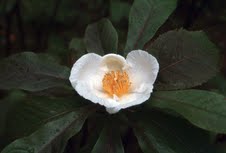Now you see it, now you don’t!
The New York Times reports that United States Supreme Court opinions have cited to materials on the internet that “are very often ephemeral.” In short, you click on and get a whole lot of nothing, and as a result: “The modern Supreme Court opinion is increasingly built on sand.” (The New York Times, 9/24/2013, p. A13.)
Moreover, this disappearing-text-dilemma is not limited to Court decisions; the problem of lost data is universal, affecting all web-users—including bloggers.
My garden club recently visited Longwood Gardens in PA., the former estate of Pierre S. du Pont. There was much to see and admire, including a very fine example of our beautiful native tree, Franklinia alatamaha. Seeing it reminded me of my blog about Franklinia’s fascinating history, so with some trepidation–triggered by the New York Times piece—I re-visited the 2012 post. Worse than I feared: The title, some of the text, and the photos were gone. Simply vanished. A pox on those responsible!!!!!!!
Here is a restored and hopefully permanent post:
I like plants with a back story, a history, and there’s none better than Franklinia alatamaha.
It all began with John Bartram (1699-1777), a botanist and nurseryman from Pennsylvania, who traveled extensively in colonial America collecting native plants for customers in the colonies as well as in Europe, including the English aristocracy. As reported by Andrea Wulf in her fascinating, informative book, The Brother Gardeners, in England, “a landscape garden filled with Bartram’s trees and shrubs had become the way to show one’s wealth and taste.” The Duke of Richmond, for example, planted 400 different American species at his estate.
This “taste” for American plants led to a rash of plant thefts, which in turn, Wulf tells us, led to a Parliamentary Act providing that plant thieves could be sent to an American penal colony. [An American penal colony? Did Wulf confuse us with Australia? I decided to do a little research of my own and discovered that from 1620-1776 about 50,000 British criminals were transported to the colonies in North America to serve out their sentences, primarily as indentured servants. It was not until a decade later that convicts were sent to Australia.]
But I digress. Back to John Bartram and Franklinia alatamaha.
On a plant-hunting trip in 1765, Bartram and his son William discovered Franklinia along the Altamaha river in Georgia. The plants were not in flower, so they could not collect seed. William finally accomplished this task on a solo return trip in 1776, and at the Bartram farm in PA successfully grew plants from the seed.
After 1803 Franklinia was never again seen in the wild; it is believed that every tree now in existence may be traced back to the seeds collected by William Bartram in 1776. Living history in our own backyards!
John Bartram died in 1777 without ever seeing the exquisite flowers of his discovery. (William’s seedlings didn’t flower until 1781.) The tree was named Franklinia in honor of John Bartram’s great friend, Benjamin Franklin, with whom he and other scholars founded the American Philosophical Society. (This prestigious Society was dedicated to furthering knowledge of the natural sciences. In 1803, in preparation for The Lewis and Clark Expedition of exploration, President Thomas Jefferson sent Meriwether Lewis to the Society to receive instruction from the nation’s leading scientists.)
In rich, acid, well-drained soil with adequate moisture, Franklinia will produce radiant, fragrant, snowy-white flowers in late summer-early fall. (Photo above) In my garden, when the flowers fade, the foliage takes on shades of vibrant red and orange. What a treasure!
Note: Franklinia is quite cold hardy (z5) and seems to do better in the Northeast than in the South–its place of origin–where it is said to be short-lived.
